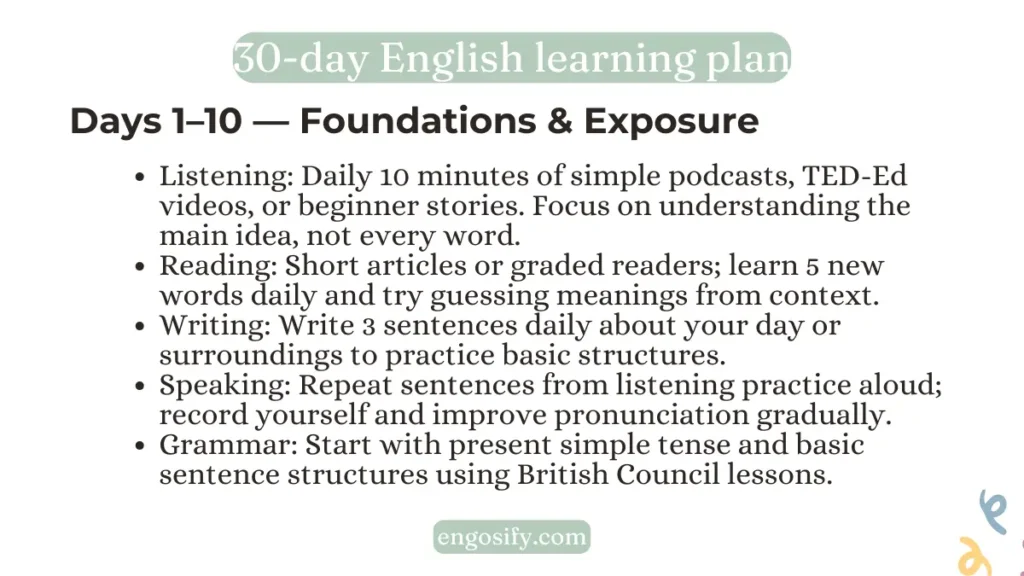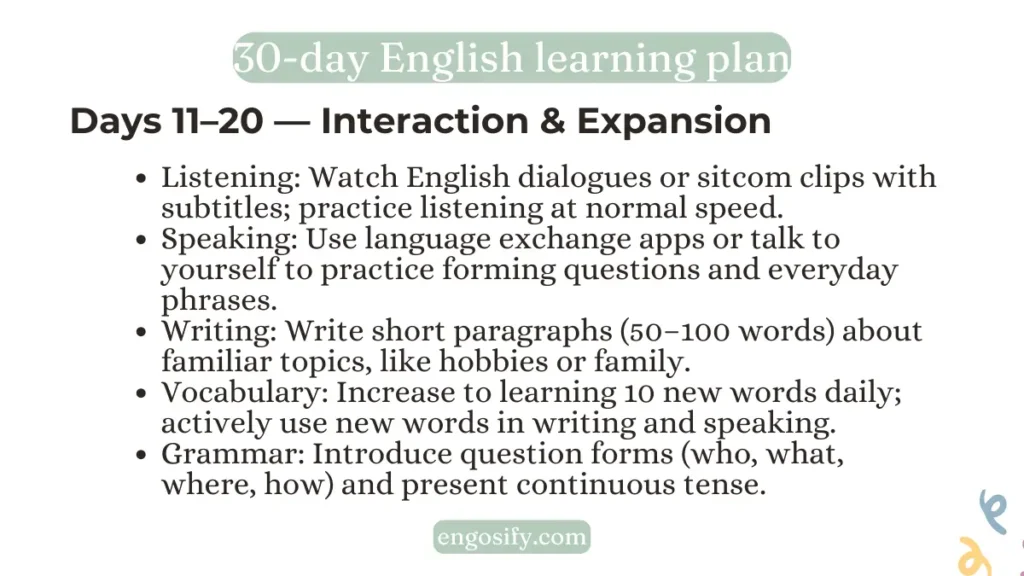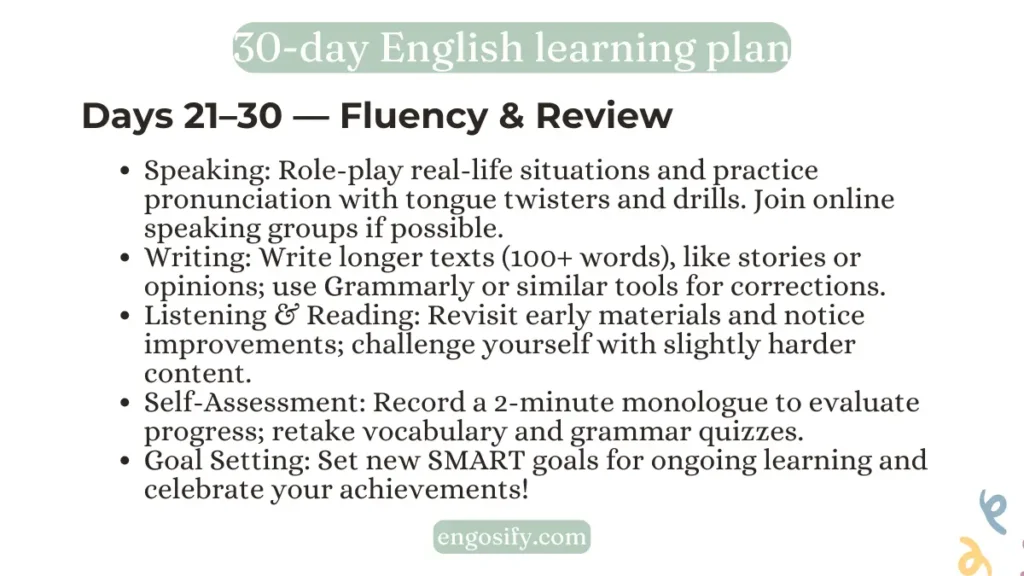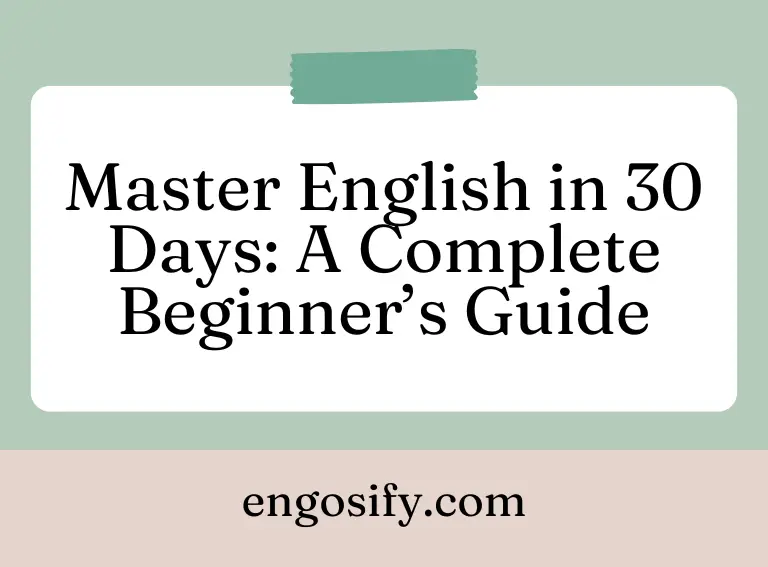Ready to learn English but don’t know where to begin? This guide is your go-to roadmap to master English in 30 days — even if you’re starting from scratch. Whether you’re learning English to travel, work, or just communicate better, this guide simplifies the process with clear steps, daily habits, and smart strategies. You’ll focus on listening, speaking, reading, writing, and vocabulary building, all broken into bite-sized weekly chunks.
We’ve designed this plan to be practical and motivating. So, if you’re someone who’s always wanted to speak fluent English but felt overwhelmed, this is your moment. Let’s dive into Part 1 and set the foundation right.
Introduction & Setup
Why learn English in 30 days?
English is the global language of opportunity. From unlocking better jobs to connecting with people around the world, learning English in just 30 days is possible—if you focus on building a strong foundation. Now, let’s be real: fluency doesn’t happen overnight, but you can go from “I know a few words” to “I can hold a basic conversation” in one month.
And guess what? This 30-day challenge is more about consistency than cramming. Ten to twenty minutes a day, done right, can transform your language skills.
What’s realistic: foundation vs. full fluency
Don’t expect to become Shakespeare in a month—but you can absolutely learn how to introduce yourself, talk about your day, ask questions, and understand basic conversations. This guide will help you lay down the core structure of the language so that fluency becomes a reachable goal, not a distant dream.
It’s all about setting realistic goals. You’ll expand your vocabulary, learn useful grammar rules, and start thinking in English—one step at a time.
How this guide works
We’ve broken the journey into 4 powerful weeks. Each week, you’ll focus on different language skills using short, actionable exercises. For example, in Week 1, you’ll build exposure by listening to native English daily, while Week 3 is all about refining your speaking and pronunciation.
Here’s what to expect:
- Daily practices like journaling, shadowing, and vocabulary challenges
- Weekly targets to keep you focused
- A mix of tools: apps, videos, conversations, and practical grammar tips
- And, most importantly, fun and motivation
To make the most of it, we recommend you bookmark resources like TED-Ed’s English listening lessons, which we’ll refer to along the way for authentic listening practice.
Week 0: Assessment & Goal‑Setting
Before diving headfirst into learning English, you need to know where you’re starting from and what you’re aiming for. Week 0 is your “preparation week.” Think of it like packing your bag before a journey—you wouldn’t hit the road without a map, right?
Self‑assessment: know your level
First things first—how much English do you already understand? Don’t worry if the answer is “almost nothing.” That’s where we all begin. But having a rough idea of your current level can make a huge difference.
You can try a quick self-test:
- Listen to a short podcast (try one from Breaking News English, which offers audio at different speeds). Can you understand the main idea?
- Read a beginner news article. How many words do you recognize?
- Try speaking for one minute about your day. Record yourself. How does it sound?
These simple exercises help you spot strengths and gaps. Are you better at reading than listening? Great—now you know where to balance your focus. And don’t stress—the goal here is progress, not perfection.
Goal‑setting: SMART goals
Now that you know where you stand, let’s talk goals. Not just any goals—SMART goals:
- Specific
- Measurable
- Achievable
- Relevant
- Time-bound
Instead of saying, “I want to learn English,” try:
- “I will learn 10 new words a day for the next 7 days.”
- “I will watch one English video each evening and write a 3-sentence summary.”
- “By Day 30, I will record a 2-minute self-introduction in English.”
Goals like these give you something to chase, and hitting them feels super rewarding. They also make learning English less abstract and more doable.
Feeling stuck? Use a habit tracker or even a sticky note on your fridge to mark your progress. Little wins = big momentum.
By the end of this week, you’ll have:
- A rough idea of your level
- A set of realistic goals
- The motivation and tools to dive into Week 1 with full energy
Weeks 1–2: Core Skills & Habits

Now that you’ve got your goals in place, it’s time to roll up your sleeves. Weeks 1 and 2 are all about immersion. You’ll build your foundation using practical, everyday English exposure. This is where the magic starts—simple routines, done consistently, can supercharge your learning.
Let’s break it down by weeks
Week 1: Foundational exposure
In your first week, focus on surrounding yourself with English. The more you listen, read, speak, and write, the more your brain gets used to the rhythm and flow of the language.
Listening: Build your ear
Start with 10–15 minutes of listening every day. Choose slow, clear English resources—like TED-Ed English listening lessons—to help you get used to real accents and pronunciation.
While you listen:
- Don’t translate word-for-word.
- Focus on the general idea.
- Repeat phrases out loud (shadowing technique).
Use subtitles if needed, but gradually reduce them. This helps you train your ear.
Speaking: Repeat and mirror
You don’t need a conversation partner to practice speaking—at least, not at first. Here’s what you can do instead:
- Choose a short sentence from your listening practice.
- Pause and repeat it out loud.
- Record yourself.
- Compare your pronunciation to the speaker’s.
It’s not about sounding perfect. It’s about building confidence and muscle memory.
Reading: Bite-sized and easy
Don’t dive into novels just yet. Stick with short, graded articles or children’s stories. Breaking News English offers simple news articles with vocabulary lists and quizzes.
Read for 10 minutes daily. Look up 2–3 new words, but don’t get stuck on every unfamiliar word. Instead, guess meanings from context and keep moving.
Writing: Tiny steps matter
Writing improves thinking. Start small:
- Write a 3-sentence diary entry every evening.
- Describe your day, your breakfast, or even the weather.
- Try to use at least one new word.
You’ll be amazed how quickly this habit helps you internalize grammar and vocab.
Week 2: Expand & interact
Once you’ve built the habit, it’s time to level up. In Week 2, you’ll dive deeper into interactive and personalized learning.
Listening: Real-life conversations
Challenge yourself with casual dialogues, sitcoms with subtitles, or YouTube videos aimed at English learners. Try repeating full sentences and mimicking intonation. Pause, rewind, repeat. Every bit helps!
Want variety? Try listening to English songs and filling in missing lyrics—it’s fun and forces your brain to catch details.
Speaking: Use it or lose it
You don’t have to wait for perfection to start talking. Even talking to yourself works! But if you’re ready, consider:
- Language exchange apps (like HelloTalk or Tandem)
- Joining a local or online English-speaking group
- Practicing in front of the mirror or narrating your daily routine
The goal here is fluency over accuracy. Don’t worry if your grammar isn’t perfect yet—just speak.
Vocabulary: Learn and use
Start building your word bank. Aim for 10–20 words a day. Use flashcards, apps like Quizlet, or write words in a notebook with example sentences. But here’s the trick:
Use each word in your speaking or writing that same day. Learning is useless if it stays in your head.
Grammar: Start with the basics
Grammar might sound boring, but it’s your language backbone. Focus on:
- Present simple vs. present continuous
- Subject + verb agreements
- Common question forms: What, Where, How, etc.
Resources like the British Council’s grammar practice offer simple explanations and exercises. It’s bite-sized, easy to follow, and super helpful.

Weeks 3–4: Fluency Practice & Refinement
Alright, you’ve made it halfway—and you’ve already done the hardest part: getting started. Weeks 3 and 4 are where you’ll shift gears from learning the basics to actually using English in real-world ways. It’s time to tighten your skills, smooth out rough edges, and get comfortable speaking with flow.
Let’s dive into the game-changing part of your 30-day plan.
Week 3: Fluency + correction
By now, you’ve got some vocabulary, a few sentence patterns, and a handful of daily routines. Week 3 is about putting it all together and sounding natural. This is your fluency bootcamp.
Interactive tasks: Start talking more
Stop memorizing and start conversing. Even short interactions help you think faster in English.
Try these:
- Do a role-play: Pretend you’re ordering food, making a hotel booking, or introducing yourself at a meeting. Talk out loud!
- Practice with a friend or tutor if possible.
- Use language exchange platforms like HelloTalk or Speaky for live chats.
Don’t worry about making mistakes. In fact, make lots of them! That’s where learning happens.
Pronunciation drills and tongue twisters
Want to speak clearly? You’ve got to train your mouth. Try tongue twisters like:
- “She sells seashells by the seashore.”
- “How can a clam cram in a clean cream can?”
Repeat slowly, then pick up speed. Also, imitate native speakers from TED-Ed’s videos or other slow-speaking YouTube channels. Focus on stress, intonation, and rhythm.
Recording yourself and listening back is pure gold here. Yes, it’s awkward—but it works!
Writing: Tell your story
You’ve been journaling and writing short entries. This week, go a bit further:
- Write a 100–150 word paragraph about your hometown, your favorite movie, or your childhood.
- Try to use connectors like because, so, although, and but to make your writing flow.
Then read your writing out loud—it helps lock in grammar and structure.
Feedback loop: Fix what’s broken
Now’s the time to start catching and correcting your common mistakes.
How?
- Use free tools like Grammarly to check your writing.
- Ask language partners for feedback.
- Record your speaking, then write down what you said. Can you spot grammar errors?
This process of reflecting and tweaking helps turn messy English into clear, confident communication.
Week 4: Review, reflect, future plan
Congrats—you’re in the final stretch! Week 4 is all about revisiting weak spots, evaluating your progress, and planning what’s next.
Revisiting weaknesses: test & review
Go back to Week 0 and re-do your self-assessment:

- Try the same podcast or article from earlier. Can you understand more now?
- Write a new self-introduction and compare it to your first one.
- Retake a grammar quiz or vocabulary list from Week 2.
Notice the difference? You’ve leveled up, big time.
This week is also your chance to catch any tricky grammar that’s still giving you trouble. Try the British Council’s grammar practice page—pick one topic a day and work through the examples.
Final self-test: Record your growth
Here’s a fun way to mark your progress:
- Record a 2-minute monologue about your English journey so far.
- Talk about what you’ve learned, how you feel, and what surprised you.
It may not be perfect, but it’s real, honest English—and that’s more than most learners ever achieve in just one month.
“Think in English” strategy
To keep growing, you’ve got to make English part of your brain. Instead of translating in your head, try this:
- Label items in your home in English.
- Narrate what you’re doing (“Now I’m making coffee. It’s hot. I’ll drink it slowly.”)
- Read your thoughts in English.
This might feel strange at first, but over time, it rewires your brain to process English naturally.
Goal-setting for beyond 30 days
Don’t stop here. Learning a language is a journey, not a race. Set new SMART goals:
- Read one graded reader book per month
- Join an English-speaking online community
- Keep writing in your journal every day
And most importantly? Celebrate how far you’ve come. You’ve gone from “just starting” to actively thinking and communicating in English.
Daily Routine & Tools
So, what’s the secret to mastering English without burning out? Simple: a consistent, doable daily routine. In this section, you’ll discover how to structure your day for maximum language growth—even if you’re short on time. We’ll also explore the best tools and resources to support your 30-day English learning journey (and beyond).
Let’s jump right in.
Typical daily routine
You don’t need to study for hours. In fact, short bursts of focused, daily English practice work best. Here’s a sample routine you can tweak to fit your lifestyle:
- Morning (10 minutes): Reading + vocabulary
Read a short article or story in English. Use something easy, like Breaking News English or a graded reader. Highlight 2–3 new words, write them down, and say them aloud. - Midday (10 minutes): Speaking + listening
Listen to a short English podcast or video clip. Pause and shadow (repeat) sentences you hear. Try TED-Ed or EnglishClass101 on YouTube. This helps improve both listening comprehension and pronunciation. - Evening (10 minutes): Writing + review
Reflect on your day by writing 3–5 sentences in your notebook. Use the vocabulary you learned earlier. Then, review and correct your grammar using a tool like Grammarly. - Bonus (5 minutes): Quick speaking practice
Talk to yourself while doing tasks (“I’m brushing my teeth now. The water is cold. My toothbrush is blue.”). Sounds silly? Maybe—but it trains your brain to think in English, which is priceless.
This routine totals just 30–35 minutes a day. It’s easy, effective, and keeps your progress moving forward—even on busy days.
Recommended tools & resources
To make learning smoother (and more fun), here are some of the top resources used by successful English learners. These tools support all four key skills—reading, writing, listening, and speaking—and they’re beginner-friendly.
Apps: Learn anywhere, anytime
- Duolingo – Great for daily vocabulary and sentence structure practice. It’s gamified, so you stay motivated.
- Quizlet – Perfect for creating flashcards and reviewing new words.
- HelloTalk – Chat with native speakers and get real-time corrections. Use it for casual language exchanges.
Websites: In-depth lessons and exercises
- British Council’s LearnEnglish site – A treasure trove of lessons, quizzes, grammar explanations, and listening exercises. Whether you want to polish your tenses or understand sentence structure, it’s all here in one spot.
- Breaking News English – Excellent for building vocabulary, improving reading, and listening to real topics at adjusted difficulty levels.
- TED-Ed – For listening practice with real speakers, engaging stories, and ideas. You’ll improve comprehension while learning about science, culture, and more.
Tools for writing & correction
- Grammarly – Your writing assistant. It spots grammar mistakes and offers suggestions to make your sentences clearer.
- Google Docs + voice typing – Try speaking your journal out loud using voice input. Great for pronunciation practice and identifying what sounds awkward.
With just a phone or laptop and 30 minutes a day, you’ve got everything you need to build English into your life. Consistency beats intensity every time. The key is to make English not just something you study, but something you live.
FAQs
Can I really learn English in 30 days?
You can’t become a professor of linguistics in one month—but yes, you can absolutely build a strong English foundation in 30 days. The key? Consistency.
If you follow this plan daily, you’ll be able to:
- Hold basic conversations
- Understand slow, clear English
- Write short paragraphs
- Use everyday vocabulary correctly
And most importantly, you’ll have the confidence to keep going. Think of 30 days as your launch pad, not the final destination.
How much time per day is needed?
You don’t need to quit your job or cancel your life. Just 30–35 focused minutes a day can spark serious growth.
Here’s the breakdown:
- 10 minutes listening
- 10 minutes speaking
- 10 minutes reading/writing
- Optional 5-minute vocabulary boost
That’s it. Use your commute, lunch break, or time before bed. What matters most is showing up daily. Little steps, big results.
How do I overcome speaking anxiety?
Ah yes—the fear of speaking English out loud. You’re not alone! Even advanced learners freeze up sometimes. But here’s the good news: speaking anxiety shrinks the more you speak.
Try this:
- Talk to yourself in the mirror. No pressure, no audience.
- Record your voice and listen back. You’ll hear where to improve.
- Use an app like HelloTalk to chat with patient native speakers.
- Join beginner-friendly forums or online meetups for low-stress practice.
Remember, nobody expects perfection. They respect effort.
What’s the best way to improve my pronunciation?
Want to sound more natural? You’ve got to train your ear and your mouth.
Here’s how:
- Shadow native speakers from TED-Ed English videos. Repeat word for word.
- Use tongue twisters like “Red lorry, yellow lorry” to improve clarity.
- Practice with sentence stress and intonation—English isn’t just about words, it’s about music.
Also, recording yourself and comparing your voice to a native speaker’s helps correct habits over time.
Which apps help the most for beginners?
There’s no shortage of language apps—but not all of them work for everyone. Try these beginner-approved picks:
- Duolingo: Great for bite-sized grammar and vocab.
- Quizlet: For building your personal vocabulary deck.
- Grammarly: Fix writing mistakes in real time.
- HelloTalk: Talk to real people, make real progress.
Pair them with strong input—like videos, short books, or the British Council’s LearnEnglish lessons—and you’ve got a winning combo.
Conclusion
Congratulations on completing your 30-day journey toward mastering English! You’ve laid a solid foundation by setting clear goals, practicing daily, and embracing all four key skills—listening, speaking, reading, and writing. Remember, language learning is a marathon, not a sprint. Keep building on what you’ve achieved, stay consistent, and don’t be afraid to make mistakes. With every small step, you’re getting closer to fluency. So keep practicing, stay curious, and most importantly, enjoy the process. Your English journey is just beginning—and the possibilities are endless!

